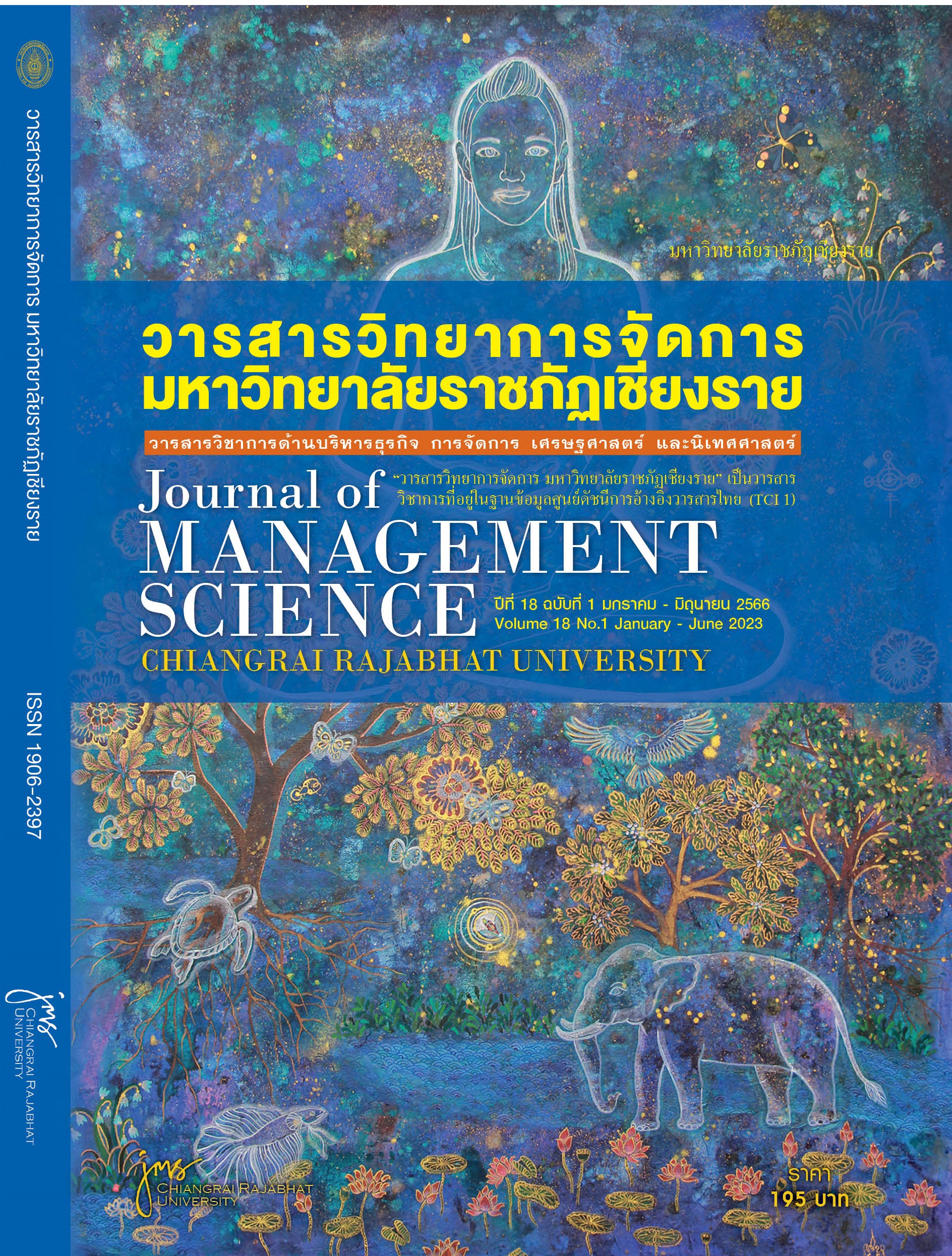ผลของทัศนคติเกี่ยวกับความเสี่ยง และความพอใจในการบริโภค ต่างเวลาต่อการสูบบุหรี่ของวัยรุ่นในจังหวัดเชียงใหม่
Main Article Content
บทคัดย่อ
การศึกษานี้ประเมินทัศนคติเกี่ยวกับความเสี่ยง (Risk Attitude) และความพอใจในการบริโภคต่างเวลา (Time Preference) เพื่อศึกษาผลกระทบที่มีต่อการตัดสินใจสูบบุหรี่ของวัยรุ่นชาย ในจังหวัดเชียงใหม่ โดยการศึกษาจากกลุ่มตัวอย่างที่มีอายุระหว่าง 15 - 24 ปี และอาศัยอยู่ในจังหวัดเชียงใหม่อย่างน้อย 1 ปีขึ้นไป จำนวน 313 คน โดยใช้แบบสอบถามออนไลน์ ในช่วงเดือนสิงหาคมถึงธันวาคม พ.ศ. 2565 โดยประเมินทัศนคติเกี่ยวกับความเสี่ยงและความพอใจในการบริโภคต่างเวลาจากการทดลอง (Experiment) ที่ให้กลุ่มตัวอย่างตัดสินใจจากสถานการณ์สมมติ การศึกษาพบว่าวัยรุ่นชายที่มีบุคคลใกล้ชิดสูบบุหรี่ทำให้กลุ่มตัวอย่างมีพฤติกรรมการสูบบุหรี่มากขึ้นเกี่ยวกับความเสี่ยงไม่ส่งผลต่อการเลือกสูบบุหรี่และปริมาณการสูบบุหรี่ แต่ความพึงพอใจในการบริโภคต่างเวลาส่งผลต่อการสูบบุหรี่ โดยอัตราคิดลดมีความสัมพันธ์เชิงบวกกับการเลือกสูบบุหรี่และปริมาณการสูบบุหรี่ นั่นคือผู้ที่ให้ความสำคัญกับการบริโภคปัจจุบันสูงกว่าจะมีพฤติกรรมการสูบบุหรี่มากกว่าผู้ประกอบการ ตลอดจนให้การสนับสนุนในการจัดหาจุดจอดและระบบการตลาดที่มีประสิทธิภาพ
Article Details

This work is licensed under a Creative Commons Attribution-NonCommercial-NoDerivatives 4.0 International License.
ทัศนะและข้อคิดเห็นของบทความที่ปรากฏในวารสารฉบับนี้เป็นของผู้เขียนแต่ละท่าน ไม่ถือว่าเป็นทัศนะและความรับผิดชอบของกองบรรณาธิการ
References
Anderson, R. L, & Mellor, M. J. (2008). Predicting health behaviors with an experimental measure of risk preference. Journal of Health Economics. 27(5), 1260 – 1274.
Attanan, W., & Sae Lim, U. (2012). Study on Thai youth smoking behaviors and factors affecting their smoking behaviors in Bangkok. Proceedings of 50th Kasetsart University Annual Conference: Education, Economics and Business Administration, Humanities and Social Sciences. Kasetsart University Academic Conference No. 50. (183-190). The Thailand Research Fund, Bangkok (Thailand).
Becker, G.S, & Murphy, K. M. (1988). A theory of rational addiction. Journal of Political Economy. 96(4), 675-700.
Bunserm, C., Suthitivanich, P. & Rawisanon, W. (2009). A Survey of Smoking Behavior among Youth in Chaiyaphum Province. Journal of Health Science Research. 3(2), 6-14.
Center for Research and Knowledge Management for Tobacco Control (2018). Thailand Tobacco Consumption Statistics Report 2018. https://shorturl.asia/fv0Au
Gruber, J. & Köszegi, B. (2001). Is Addiction Rational? Theory and Evidence. The Quarterly Journal of Economics. 116(4), 1261-1303.
Harrison,G., Lau, I. M., & Williams, B. M. (2002). Estimating Individual Discount Rates in Denmark: A Field Experiment. The American Economic Review. 92(5), 1606 – 1617.
Harrison,G., Morten, I., & E.,E.R. (2010). Individual discount rate and smoking: Evidence from a field experiment in Denmark. Journal of health economics. 29(5), 708-717.
Harrison, G., Hofmeyr, A., Ross, D.& Swarthout, T. J. (2018). Risk Preferences, Time Preferences, and Smoking Behavior, Southern Economic Journal. 85(2), 313-348.
Heatherton, T.F., Kozlowski, L.T., & Fagerstrom, K. O. (1991) The Fagerström Test for Nicotine Dependence: a revision of the Fagerström Tolerance Questionnaire. Journal of National Library of Medicine. 86(9),1119 – 1127.
Hershfield, H. E., Goldstein, D. G., Sharpe, W. F., Fox, J., Yeykelis, L., Carstensen, L. L., & Bailenson, J. N. (2019). Increasing saving behavior through age-progressed renderings of the future self. Journal of marketing research. 48(SPL), 23-37.
Himakalasa, W. (2018). The research report provided Atlanta's data on policies that avoid these things. (Research Report). Institute of Public Policy Studies Foundation.
Holt, A.C., & Laury, K. S. (2002). Risk Aversion and Incentive Effects. Journal of American Economic Review. 92(5), 1644-1655.
Ida, T., & Goto, R. (2009). Simultaneous Measurement of Time and Risk Preferences: Stated Preference Discrete Choice Modeling Analysis Depending on Smoking Behavior. Interational Economic Review. 50(4), 1169-1182.
Inmunkong, S. (2008). A Study of the smoking behavior and developing of the program for decreasing smoking behaviors of female students. (Master of Education Thesis). Srinakharinwirot University
Jaruchit, S., Srisuriyawet, R., & Homsin, P. (2015). Factors related to regular smoking among male students. vocational college Chanthaburi Province Journal of Nursing and Education. 8(1), 59-71.
Jinkyung, N., Chih-Mao, H., & Denise, C. P. (2017) When Age and Culture Interact in an Easy and Yet Cognitively Demanding Task: Older Adults, But Not Younger Adults, Showed the Expected Cultural Differences. Journal frontiers in Psychology. 1-11.
Komonpaisarn, T. (2020). The Estimation of Economic Cost of Tobacco Smoking in Thailand 2017. (Research Report). Center for Research and Knowledge Management for Tobacco Control
Kuder, G. F., & Richardson, M. W. (1937). The theory of the estimation of test reliability. Journal of Psychometrika. 151–160.
Miura, T. (2019). Does time preference affect smoking behavior? a dynamic panel analysis. Journal of Behavioral and Experimental Economics. 170-180.
National Statistical Office. (2019). Demographic Statistics. Population and housing. Retrieved August 24, 2020, from http://statbbi.nso.go.th/staticreport/ page/sector/th/01.aspx
Pfeifer, C. (2012). A Note on Smoking Behavior and Health Risk Taking. Nordic Journal of Health Economics. 135-151.
Taphaopong, J. (2007). Smoking behavior of students during the third grade at Srinakharinwirot University Demonstration School, Pathumwan. (Master of Education). Srinakharinwirot University.
Thongluea, K. (2007). Factors related to smoking among male vocational students. Samut Songkhram Province (Degree Thesis). Kasetsart University
Tobin, J. (1958). Estimation of relationships for limited dependent variables. Journal of Econometrica. 26(1), 24 –36.
United Nations. (2020). Department of Economic and Social Affairs. Retrieved August 18, 2020, from https://www.un.org/%20development/desa/youth/what-we-do/faq.html
World Health Organization. (2011). Tobacco questions for surveys: a subset of key questions from the Global Adult Tobacco Survey (GATS): global tobacco surveillance system. Retrieved August 18, 2020, from https://apps.who.int/iris/handle/10665/87331
World Health Organization. (2020). Tabacco. Retrieved August 18, 2020, from https://www.who.int/news-room/fact- sheets/detail/tobacco

